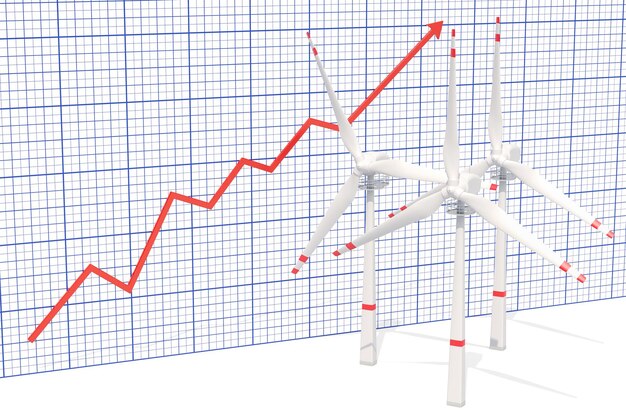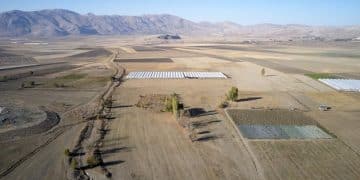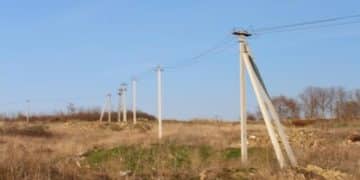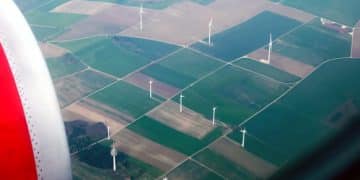Renewable Energy Surge: Impact on US Natural Gas Prices in 2025

In 2025, the projected 12% increase in US renewable energy consumption is expected to exert downward pressure on natural gas prices, potentially leading to reduced demand and increased competition in the energy market as renewables become more prevalent.
The United States energy landscape is undergoing a significant transformation, with renewable energy sources playing an increasingly prominent role. As the nation strives to reduce its carbon footprint and transition towards cleaner energy alternatives, the anticipated 12% surge in renewable energy consumption by 2025 is poised to reshape the dynamics of the natural gas market. The question is: What Impact Will the Projected 12% Increase in US Renewable Energy Consumption Have on Natural Gas Prices in 2025?
Understanding the Renewable Energy Landscape in the US
The renewable energy sector in the United States has experienced remarkable growth in recent years, driven by technological advancements, government incentives, and increasing environmental awareness. As the cost of renewable energy technologies continues to decline, they are becoming increasingly competitive with traditional fossil fuels like natural gas.
Current State of Renewable Energy
Currently, renewable energy sources such as solar, wind, hydro, and geothermal contribute a significant portion of the overall energy mix in the US. The expansion of renewable energy capacity has been particularly pronounced in states with favorable policies and abundant natural resources, leading to a diversified energy portfolio.
Factors Driving Renewable Energy Growth
Several factors are propelling the growth of renewable energy in the US. These include:
- Federal and state government policies promoting renewable energy adoption through tax credits, subsidies, and mandates.
- Advancements in renewable energy technologies, such as solar panels and wind turbines, leading to improved efficiency and reduced costs.
- Growing public demand for clean energy solutions and increasing awareness of the environmental impacts of fossil fuels.
- Corporate sustainability initiatives and commitments to reduce carbon emissions, driving demand for renewable energy procurement.
In conclusion, the renewable energy landscape in the US is rapidly evolving, with significant growth driven by supportive policies, technological advancements, and increasing environmental awareness. As renewable energy sources continue to gain traction, they are poised to exert a growing influence on the natural gas market.

Natural Gas Market Dynamics in the United States
Natural gas plays a crucial role in the US energy market, serving as a primary fuel source for electricity generation, heating, and industrial processes. The natural gas market is influenced by a complex interplay of factors, including supply and demand dynamics, infrastructure constraints, and regulatory policies.
Overview of Natural Gas Supply and Demand
The US natural gas market is characterized by abundant supply, largely due to the shale gas revolution. Technological advancements in hydraulic fracturing and horizontal drilling have unlocked vast reserves of natural gas, leading to increased production and lower prices. On the demand side, natural gas consumption is driven by electricity generation, residential and commercial heating, and industrial applications.
Key Factors Influencing Natural Gas Prices
Several factors influence natural gas prices in the US, including:
- Weather patterns, particularly seasonal temperature variations, which affect demand for heating and cooling.
- Natural gas storage levels, which serve as a buffer against supply disruptions and demand fluctuations.
- Infrastructure constraints, such as pipeline capacity limitations, which can impact regional price differentials.
- Geopolitical events and global energy market dynamics, which can influence natural gas imports and exports.
The Role of Natural Gas in Electricity Generation
Natural gas is a significant fuel source for electricity generation in the US, accounting for a substantial portion of the overall power mix. The efficiency and flexibility of natural gas-fired power plants make them a valuable asset for meeting peak electricity demand and providing grid stability. However, the increasing penetration of renewable energy sources is gradually displacing natural gas in the electricity generation sector.
In conclusion, the natural gas market in the US is characterized by abundant supply, diverse demand drivers, and a complex interplay of factors influencing prices. As renewable energy sources continue to gain market share, they are poised to reshape the dynamics of the natural gas market and impact its role in the energy mix.
Projected Increase in Renewable Energy Consumption
The projected 12% increase in US renewable energy consumption by 2025 represents a significant milestone in the nation’s transition towards a cleaner energy future. This growth is expected to have far-reaching implications for the energy market, particularly with regard to natural gas prices.
Analysis of the Projected Growth Rate
The projected 12% increase in renewable energy consumption is based on various factors, including government policies, technological advancements, and market trends. The growth rate is expected to vary across different renewable energy sources, with solar and wind power leading the way due to their declining costs and increasing competitiveness.
Impact on Different Renewable Energy Sources
The projected increase in renewable energy consumption is expected to impact different renewable energy sources in varying degrees. Solar and wind power are likely to experience the most significant growth, driven by their declining costs and increasing deployment rates. Hydropower, geothermal, and biomass are also expected to contribute to the overall growth, albeit at a slower pace.

Regional Variations in Renewable Energy Adoption
Renewable energy adoption rates vary significantly across different regions in the US, depending on factors such as state policies, resource availability, and grid infrastructure. States with supportive policies and abundant renewable energy resources, such as California and Texas, are leading the way in renewable energy deployment. Other states are also catching up, driven by increasing cost competitiveness and growing environmental awareness.
In summary, the projected 12% increase in US renewable energy consumption by 2025 holds significant implications for the energy market. It is poised to reshape the dynamics of the natural gas market, impact fossil fuel consumption, and accelerate the transition towards a cleaner, more sustainable energy future.
Impact on Natural Gas Prices
The projected increase in renewable energy consumption is expected to exert downward pressure on natural gas prices in the US. As renewable energy sources gain market share, they will displace natural gas in electricity generation and other sectors, leading to reduced demand and increased competition.
Demand Displacement
As renewable energy sources such as solar and wind power become more prevalent, they will displace natural gas in electricity generation, reducing the demand for natural gas as a fuel source. This demand displacement is expected to be particularly pronounced during periods of high renewable energy output, such as sunny and windy days.
Price Competition
The increasing competitiveness of renewable energy sources is also expected to put downward pressure on natural gas prices. As the cost of renewable energy technologies continues to decline, they are becoming increasingly competitive with natural gas-fired power plants, leading to increased price competition in the electricity market. This competition is likely to intensify as renewable energy capacity expands and becomes more cost-effective.
Impact on Natural Gas Infrastructure
The projected increase in renewable energy consumption could also impact natural gas infrastructure, such as pipelines and storage facilities. As demand for natural gas declines, the utilization rates of these facilities may decrease, potentially leading to stranded assets and reduced investment in new infrastructure. This could create challenges for the natural gas industry and impact its long-term viability.
In conclusion, the projected increase in renewable energy consumption is expected to exert downward pressure on natural gas prices in the US. Demand displacement, price competition, and potential impacts on natural gas infrastructure are all factors that could contribute to lower natural gas prices in the coming years. The magnitude of this impact will depend on various factors, including the pace of renewable energy deployment, technological advancements, and government policies.
Potential Market Responses and Adaptations
In response to the projected increase in renewable energy consumption and its potential impact on natural gas prices, the natural gas industry may need to adapt and explore new market opportunities to remain competitive.
Exploring New Demand Sectors
The natural gas industry could explore new demand sectors to offset the decline in electricity generation. These could include:
- Increased use of natural gas in industrial processes, such as manufacturing and chemicals production.
- Expansion of natural gas exports, particularly to countries with growing energy demand.
- Development of natural gas-powered vehicles and transportation infrastructure.
- Use of natural gas as a feedstock for hydrogen production, which could play a role in a future hydrogen economy.
Technological Innovations
Technological innovations could also help the natural gas industry adapt to the changing energy landscape. These include:
- Development of more efficient natural gas-fired power plants with lower emissions.
- Implementation of carbon capture and storage (CCS) technologies to reduce greenhouse gas emissions from natural gas combustion.
- Use of renewable natural gas (RNG) produced from organic waste and biomass as a low-carbon alternative to conventional natural gas.
Policy and Regulatory Changes
Policy and regulatory changes could also play a role in shaping the future of the natural gas market. These could include:
- Implementation of carbon pricing mechanisms to incentivize the use of low-carbon energy sources.
- Development of policies to support the integration of renewable energy and natural gas into the grid.
- Regulation of methane emissions from natural gas production and transportation.
In summary, the natural gas industry needs to adapt to the projected increase in renewable energy consumption and its potential impact on prices. Exploring new demand sectors, pursuing technological innovations, and advocating for supportive policies are all strategies that could help the industry remain competitive in the evolving energy market.
Long-Term Implications and Future Outlook
The long-term implications of the projected increase in renewable energy consumption extend beyond the natural gas market, impacting the broader energy landscape and the nation’s efforts to address climate change.
Impact on Climate Change Mitigation
The increasing penetration of renewable energy sources is essential for mitigating climate change by reducing greenhouse gas emissions from the energy sector. Renewable energy sources such as solar and wind power produce little to no greenhouse gas emissions during operation, making them a clean alternative to fossil fuels like natural gas.
Transition to a Low-Carbon Economy
The transition to a low-carbon economy requires a fundamental shift away from fossil fuels and towards cleaner energy sources. Renewable energy sources are expected to play a central role in this transition, providing a sustainable and environmentally friendly alternative to conventional energy sources. As renewable energy technologies continue to advance and become more cost-effective, they will be critical for achieving deep decarbonization of the energy sector.
Energy Security and Independence
Investing in renewable energy can also enhance energy security and independence by reducing reliance on imported fossil fuels. Renewable energy resources are abundant and geographically dispersed, making them a reliable and resilient source of energy that can reduce vulnerability to price volatilities and geopolitical risks.
In conclusion, the projected increase in renewable energy consumption has far-reaching implications for the energy landscape and the nation’s efforts to address climate change. As renewable energy sources continue to gain market share, they will play a central role in the transition to a low-carbon economy and enhance energy security and independence.
| Key Point | Brief Description |
|---|---|
| ☀️ Renewable Increase | The US aims for a 12% rise in renewable energy use by 2025. |
| 📉 Natural Gas Impact | Increased renewables may lower natural gas demand and prices. |
| 🌱 Green Economy | This shift supports climate goals and energy independence. |
| ⚡ Market Adaptations | Gas industry seeks new uses and tech to stay competitive. |
FAQ
▼
Increased renewable energy production will likely decrease the demand for natural gas in electricity generation, as renewables start to replace gas-fired power plants.
▼
Solar and wind power are projected to experience the most significant growth due to their declining costs and increasing efficiency, making them competitive energy sources.
▼
Yes, the natural gas industry can adapt by exploring new uses in industry, transportation, and hydrogen production, as well as adopting carbon capture technologies.
▼
Government policies, such as tax incentives and renewable energy mandates, are crucial in driving the growth of renewable energy and influencing the pace of the energy transition.
▼
Increased reliance on renewable energy sources is expected to enhance energy security by lessening dependence on imported fossil fuels and promoting a more diverse and resilient energy supply.
Conclusion
In conclusion, the projected 12% increase in US renewable energy consumption by 2025 will likely exert downward pressure on natural gas prices, reshape market dynamics, and accelerate the transition to a cleaner energy future. While challenges exist, adaptation and innovation within the natural gas industry, coupled with supportive policies, can help navigate this evolving energy landscape and ensure a sustainable and secure energy future for the nation.





